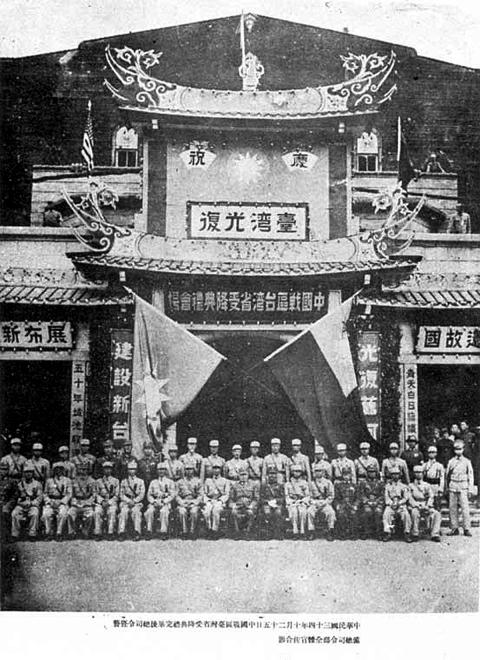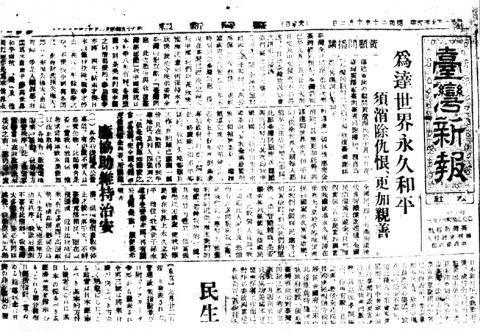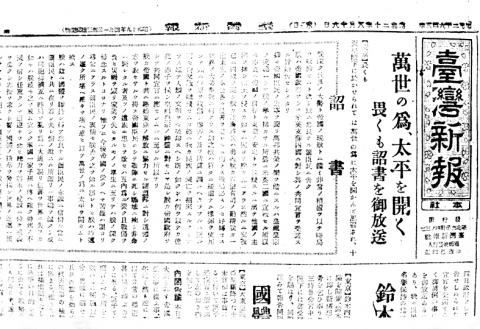Emperor Hirohito’s voice could be heard through radios across the Japanese Empire that day, including Taiwan. Not everyone had radios back then, but those who did didn’t hesitate to spread the news. It was Aug. 15, 1945, and Japan had officially announced its surrender to the Allies.
A much contested outcome of the Cairo Declaration of 1943 is that Taiwan, which Qing Dynasty China ceded to Japan in the treaty of Shimonoseki following its defeat in the First Sino-Japanese War, would return to China, then ruled by the Chinese Nationalist Party (KMT).
Although KMT leader Chiang Kai-shek (蔣介石) appointed Chen Yi (陳儀) as governor general of Taiwan on Aug. 29, Chen didn’t land until Oct. 24. The next day, he formally accepted the Japanese governor-general’s surrender.

Photo courtesy of Wikipedia Commons
While the KMT was busy planning its arrival, what was going on in Taiwan between Aug. 15 and Oct. 25?
AFTER THE SURRENDER
The Taiwanese attitude toward the newcomers varies depending on who you ask, and will not be discussed here. Most sources agree, though, that the majority of people were more than happy to see the Japanese go.

Photos: Han Cheung,Taipei Times
Sources point to a short-lived Taiwanese independence attempt right after the surrender was announced, where Japanese military officers allegedly plotted with prominent Taiwanese to resist the Chinese takeover, though the level of Taiwanese involvement is disputed. This plan was abandoned just a week later after governor-general Ando Rikishi publicly warned against any such actions.
Historian and author Tseng Chien-min (曾建民) writes in 1945: Taiwan at Daybreak (1945: 破曉時候的台灣) that at least for the first 20 days, all Japanese colonial government activities went on as usual, as if nothing had changed. Tseng says that it was the Japanese police and members of the Japan-friendly volunteer fighting corps who kept social order during that time.
Because of that, Tseng says that Taiwanese were wary of celebrating openly at first, only doing so after the surrender was formally signed on Sept. 2.

Photo: Han Cheung,Taipei Times
Tseng says that as Japanese power waned, social order fell into the hands of local groups such as the Three Principles Youth Group (三民主義青年團).
According to History of Taiwan under Japanese Rule by Suemitsu Kazuya, on Sept. 1, 18 US and Chinese soldiers and officials arrived to liberate surviving Allied prisoners of war. More US troops landed for the same purpose on Sept. 5 and Sept. 7.
On Sept. 14, staff with the Taiwan Takeover Preparation Committee (台灣接收準備委員會) landed, making contact with the remaining Japanese military. Between Sept. 20 and Sept. 26, between 200 and 300 KMT troops occupied airports in Taipei, Taichung, Chiayi and Pingtung.
Taiwan’s only newspaper at that time, the Japanese-language Taiwan Shin Pao (台灣新報) published its first Chinese article on Oct. 2. By Oct. 10, Chinese had become the paper’s main language.
The entirely Chinese Min Pao (民報) was established on Oct. 10, and was known for being progressive and outspoken.
Committees to welcome the new government sprung up in various cities, making and delivering Republic of China (ROC) flags to offices and schools, putting up patriotic banners and teaching locals to speak Mandarin. According to a Min Pao article, almost 4,000 people showed up to a Mandarin class on Oct. 21.
What many call the “government-less” period lasted until Oct. 6, when the Taiwan Garrison Command’s (台灣警備總司令部) forward command (前進指揮所) arrived. It immediately issued several orders, including that administrative and legal functions were to still be carried out by the Japanese governor-general’s office until Chen Yi’s arrival and that all public functions such as traffic and mail should remain operating as usual. Education was to continue as before, with the exception that anything that challenged the ROC’s “status or educational philosophy” should be deleted.
Taiwanese observed Double Ten National Day for the first time with a huge celebration at the Taipei Public Assembly Hall, which is now Zhongshan Hall (中山堂).
More troops continued to arrive in Taiwan over the following few weeks, and spirits remained high, paving the way for Chen Yi’s big day. What happened in the next few years is another story.
OTHER EVENTS THIS WEEK IN HISTORY
Construction on the Sun Yat-sen Freeway began on Aug. 14, 1971, taking seven years to complete. Two oft-visited spots in the country opened to the public on Aug. 10, 1979: Leofoo Village Safari Park (六福村野生動物園) and Provincial Highway 2, better known as North Coastal Highway (北部濱海公路).

Most heroes are remembered for the battles they fought. Taiwan’s Black Bat Squadron is remembered for flying into Chinese airspace 838 times between 1953 and 1967, and for the 148 men whose sacrifice bought the intelligence that kept Taiwan secure. Two-thirds of the squadron died carrying out missions most people wouldn’t learn about for another 40 years. The squadron lost 15 aircraft and 148 crew members over those 14 years, making it the deadliest unit in Taiwan’s military history by casualty rate. They flew at night, often at low altitudes, straight into some of the most heavily defended airspace in Asia.

Many people in Taiwan first learned about universal basic income (UBI) — the idea that the government should provide regular, no-strings-attached payments to each citizen — in 2019. While seeking the Democratic nomination for the 2020 US presidential election, Andrew Yang, a politician of Taiwanese descent, said that, if elected, he’d institute a UBI of US$1,000 per month to “get the economic boot off of people’s throats, allowing them to lift their heads up, breathe, and get excited for the future.” His campaign petered out, but the concept of UBI hasn’t gone away. Throughout the industrialized world, there are fears that

Taiwan’s democracy is at risk. Be very alarmed. This is not a drill. The current constitutional crisis progressed slowly, then suddenly. Political tensions, partisan hostility and emotions are all running high right when cool heads and calm negotiation are most needed. Oxford defines brinkmanship as: “The art or practice of pursuing a dangerous policy to the limits of safety before stopping, especially in politics.” It says the term comes from a quote from a 1956 Cold War interview with then-American Secretary of State John Foster Dulles, when he said: ‘The ability to get to the verge without getting into the war is

Like much in the world today, theater has experienced major disruptions over the six years since COVID-19. The pandemic, the war in Ukraine and social media have created a new normal of geopolitical and information uncertainty, and the performing arts are not immune to these effects. “Ten years ago people wanted to come to the theater to engage with important issues, but now the Internet allows them to engage with those issues powerfully and immediately,” said Faith Tan, programming director of the Esplanade in Singapore, speaking last week in Japan. “One reaction to unpredictability has been a renewed emphasis on